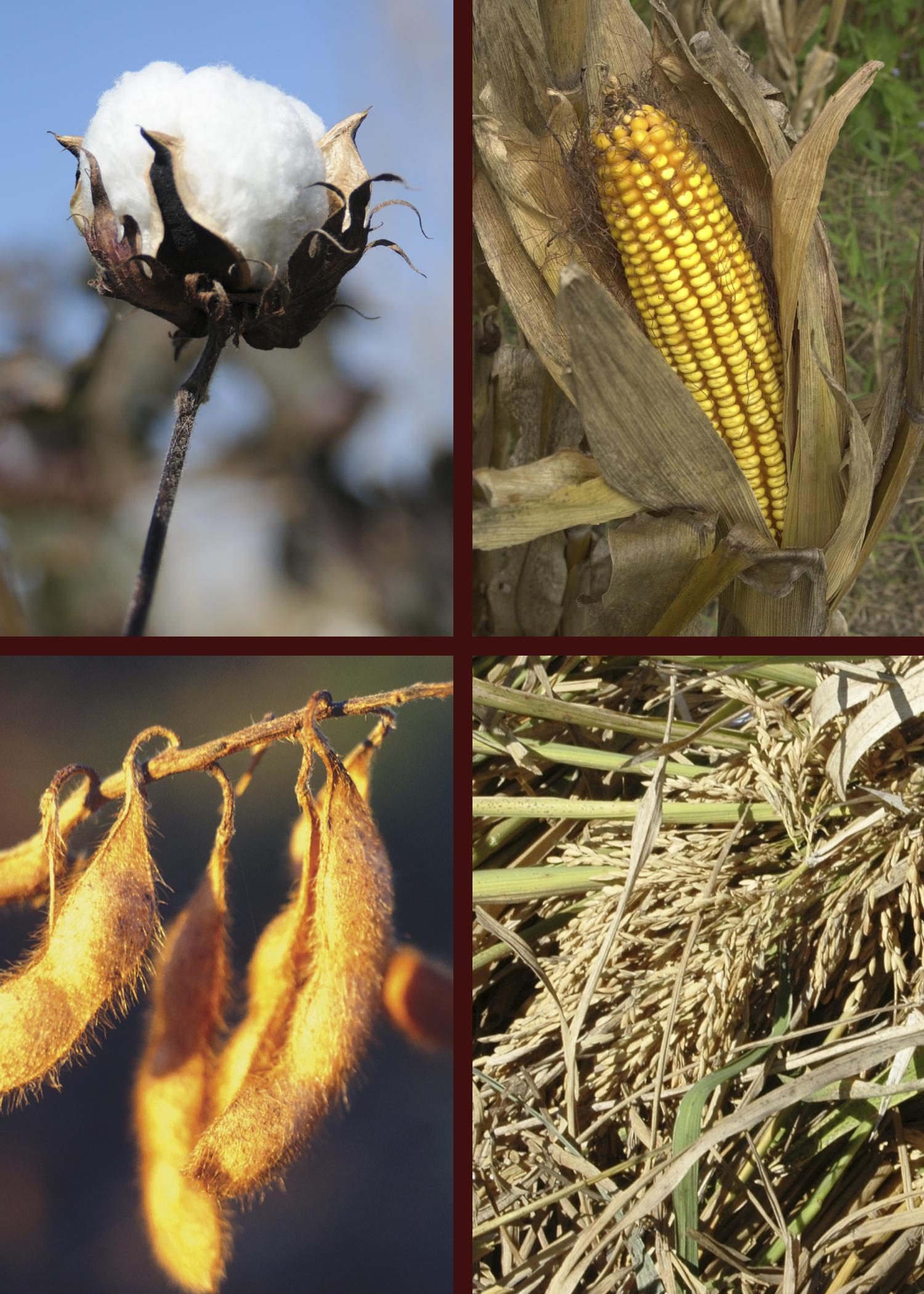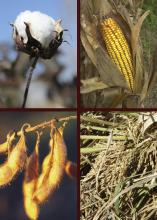Information Possibly Outdated
The information presented on this page was originally released on May 29, 2015. It may not be outdated, but please search our site for more current information. If you plan to quote or reference this information in a publication, please check with the Extension specialist or author before proceeding.
State's 'Big 4' row crops post record yields in 2014
STARKVILLE, Miss. -- Mother Nature may deserve most of the credit, but management decisions by some “boots on the ground” also contributed to Mississippi’s record yields in cotton, soybeans, corn and rice in 2014.
The U.S. Department of Agriculture recently released the official cotton yield averages, placing Mississippi fields at an all-time high of 1,232 pounds per acre. Cotton joins other 2014 crops with records, including soybeans at 52 bushels per acre, corn at 185 bushels per acre and rice at 7,420 pounds per acre.
Brian Williams, assistant professor of agricultural economics for the Mississippi State University Extension Service, said the state’s farmers have enjoyed near-perfect growing conditions the last several years. The results have been consecutive record or near-record yields.
“Market prices, on the other hand, have not been as impressive,” he said. “The national corn crop was very good last year, enabling us to replenish our supplies on hand. That has pushed prices down, which is good for livestock producers, including poultry and catfish, but it is bad news for corn growers.”
Williams said agronomists and ag economists helped growers make management decisions throughout the year.
“It is good to see our producers doing so well, especially when growers in other states have had weather challenges,” he said. “It stresses the importance of marketing your crops -- locking in on better prices. Growers must keep an eye on the market and research their decisions. They need to be sure they know their production costs and the price needed to cover those costs.”
Williams said 2014 prices lagged on all four crops. Cotton averaged 60 cents per pound, rice averaged $13 per hundredweight, corn averaged $4.30 per bushel and soybeans averaged $11.10 per bushel.
Darrin Dodds, state Extension cotton specialist and a researcher with the Mississippi Agricultural and Forestry Experiment Station, said cooler-than-normal nights were important in developing record yields.
“Cotton did not have as many fruiting nodes per plant last year; however, plants retained a higher percentage of bolls on those positions than usual, which contributed to higher yields,” he said. “Mississippi had a favorable fall in that temperatures stayed hot later to mature out the crop. Also, we did not have excessive fall rains to reduce yields or complicate harvest.”
Additional advantages for cotton included fewer plant bugs and thrips than in 2013.
“The biggest thing with any crop is putting the right variety on the right land,” Dodds said. “MSU variety trials play into that, along with a grower’s personal experience and consulting with neighbors and professionals.”
Erick Larson, Extension corn specialist and MAFES researcher, said MSU’s consulting and scouting efforts in corn have improved significantly over the last decade.
“Years ago, most consulting efforts were focused on cotton, but now, corn, soybeans and other crops are also closely scouted,” he said. “Our Extension specialists also put a lot of effort into getting timely, key information to the row-crop community through the Mississippi Crop Situation Blog, and this has been very successful.”
Larson said MSU’s Corn Verification Program has helped growers see the importance of strategies designed to address the state’s limitations and new technology.
“We focus efforts on strategies that minimize risks associated with crop limitations, such as excessive rainfall, which was a major issue last summer. Therefore, we implement nitrogen management strategies designed to limit losses and improve crop response to this expensive input. We are also using technology and better knowledge of crop needs to drastically improve irrigation scheduling.”
Larson said daily activities in fields are helping specialists identify problems early so agronomists can address them through education and new research.
State Extension soybean specialist Trent Irby said each year, farmers and consultants strive to maximize yield and profitability through decisions from variety selection to insect, disease and weed management. But along with that, favorable weather is always welcome to help farmers reach those top-end yields.
“Things got off to a slow start with planting and early-season challenges due to cool, wet conditions,” he said. “But many areas of Mississippi benefited from favorable rains and lower-than-normal temperatures at key times last season.”
Irby said growers pushed through these and other challenges and, at the end of the season, successfully harvested a record crop.
Bobby Golden, Extension rice agronomist and MAFES researcher at Stoneville, suggested that the cool summer may have helped yield, but the cold, wet spring did not.
“Rice did not have an ideal year to start. Wet conditions pushed planting a month later than normal, delayed herbicide applications and created challenges for nitrogen management,” he said. “When rice should have been dry, it was very wet. It’s definitely easier to grow rice in a dry year than a wet year.”
Golden said Mississippi rice growers basically produced two rice crops in 2014: one was timely and the second was later.
“The later crop was still in the planting window, but on the tail end of it. That meant any slight problem would cause growers to lose yields faster,” he said. “Weed control and nitrogen fertilizer management ran neck-and-neck as the greatest challenges.”
Golden said MSU researchers and Extension specialists worked hard to help consultants and growers manage fields through other issues such as armyworms and rice blast.
“The MSU rice team addressed insects, fertility, herbicide drift and diseases challenges in some very adverse conditions,” he said. “To have produced a record yield in those conditions is amazing and a testament to our producers. They showed great resiliency to make it through a tough year.”






